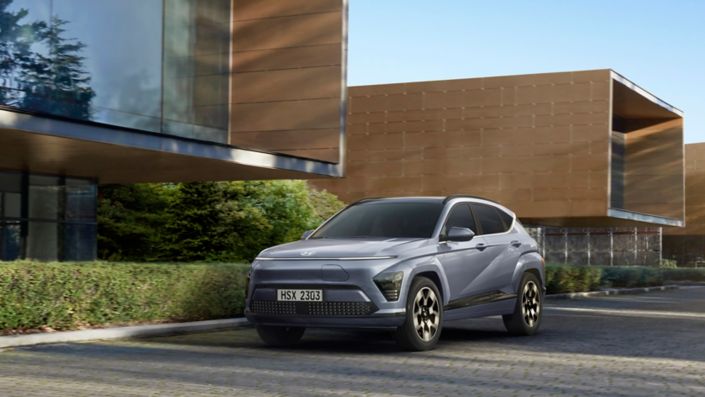SUVs combine space, comfort, technology and looks. From their earliest days transporting train passengers and luggage, through their use as a tough four-wheel durable machine for the US Army, the SUV is most definitely a suburban driver favourite today.
Hyundai Motor’s SUV line-up accounts for one third of Hyundai vehicle sales in Europe. With the arrival of the All-New KONA, the company is adding a fourth SUV to its range on the continent.
Named after the KONA district on the Big Island of Hawaii, the car continues Hyundai’s new design identity with an expressive and powerful front dominated by the cascading grille, the company’s signature look.
Other features teased ahead of its premiere in the coming months include twin headlamps with the LED Daytime Running Lights positioned on top of the LED headlights, and like other SUVs, the elevated seating position provides better visibility for drivers. A new feature is the head-up display projecting key driving information directly into the driver’s line of sight, and is a Hyundai first.
The All-New KONA will be the latest Hyundai SUV model in Europe, following on from a range of award-winning and customer favourite models.
Tucson
The All-New Tucson became the fastest-selling Hyundai car in Europe since its launch in September 2015. The Tucson’s distinctive athletic style has won design recognition including the iF Design Award 2016, and was named Best Car of the Year 2016 in Spain by a leading newspaper. The Hyundai SUV is produced at the company’s Nosovice factory, in the Czech Republic. It is engineered and tested in Europe to meet European requirements with, for example, a new chassis focused on ride comfort and driving dynamics.

Santa Fe
First launched in 2001, the Santa Fe was Hyundai’s first entry into the SUV market and is now the car manufacturer’s longest-running European model. Named after the capital of the state of New Mexico, its look was dreamt up at Hyundai's Californian design studio and built in the world's largest car factory in Ulsan, South Korea. Two generations on, the new Santa Fe has won a string of accolades such as Auto Express's ‘Best large SUV’ and Cars.com's ‘Family car of the year’. The Grand Santa Fe is the larger version, available as a six or seven-seater, bigger in length and boasting a longer wheelbase for even more room and comfort.

ix35 Fuel Cell
Hyundai has also combined its experience and expertise with the SUV segment with alternative energy solutions. The ix35 Fuel Cell continues Hyundai’s dedicated fuel cell research and vision for a future of sustainable mobility. It’s the world's first mass-produced and publicly available vehicle of this kind. Powered by hydrogen, the ix35 Fuel Cell emits only water vapour.

Consumption Data*
Grand Santa Fe
Diesel Engines
2.2 CRDi (200 PS): Fuel consumption combined: 7.6 l/100 km; urban: 9.6 l/100 km;
extra-urban: 6.5 l/100 km; CO2 emissions combined: 199 g/km
Santa Fe
Gasoline Engines
2.4 GDi (188 PS): Fuel consumption combined: 9.4 l/100 km; urban: 12.9 l/100 km;
extra-urban: 7.4 - 7.3 l/100 km; CO2 emissions combined: 219 - 218 g/km
Diesel Engines
2.0 CRDi (150 PS): Fuel consumption combined: 6.7 - 5.8 l/100 km; urban: 8.2 - 6.8 l/100 km;
extra-urban: 6.0 - 5.2 l/100 km; CO2 emissions combined: 177 - 154 g/km
2.2 CRDi (200 PS): Fuel consumption combined: 6.6 - 5.9 l/100 km; urban: 8.0 - 7.1 l/100 km;
extra-urban: 5.9 - 5.1 l/100 km; CO2 emissions combined: 174 - 155 g/km
Tucson
Gasoline Engines
1.6 GDi (132 PS): Fuel consumption combined: 6.3 l/100 km; urban: 7.9 l/100 km;
extra-urban: 5.4 l/100 km; CO2 emissions combined: 147 g/km
1.6 GDi (177 PS): Fuel consumption combined: 7.6 - 7.1 l/100 km; urban: 10.0 - 9.0 l/100 km;
extra-urban: 6.5 - 5.8 l/100 km; CO2 emissions combined: 177 - 165 g/km
Diesel Engines
1.7 CRDi (116 PS): Fuel consumption combined: 4.6 l/100 km; urban: 5.4 l/100 km;
extra-urban: 4.1 l/100 km; CO2 emissions combined: 119 g/km
1.7 CRDi (141 PS): Fuel consumption combined: 4.9 l/100 km; urban: 5.4 l/100 km;
extra-urban: 4.7 l/100 km; CO2 emissions combined: 129 g/km
2.0 CRDi (136 PS): Fuel consumption combined: 6.0 - 4.8 l/100 km; urban: 7.0 - 5.6 l/100 km;
extra-urban: 5.3 - 4.4 l/100 km; CO2 emissions combined: 156 - 127 g/km
2.0 CRDi (185 PS): Fuel consumption combined: 6.5 - 5.9 l/100 km; urban: 8.0 - 7.1 l/100 km;
extra-urban: 5.6 - 5.2 l/100 km; CO2 emissions combined: 170 - 154 g/km
ix35 Fuel Cell
Electric engine / Fuel Cell (100 kW (136 PS)): Fuel efficiency combined: 0.95 kg/100 km; urban: 0.89 kg/100 km; extra-urban: 0.99 kg/100 km; CO2 emissions combined: 0 g/km













